#palaemonetes
Note
sorry i didnt mean to send you just "yay"
so ill make it you by asking you something
whats the most fascinating shrimp youve seen
I think all of them are fascinating + deserve everything <3 but the one who stands out to me is the Glass Shrimp, or Palaemonetes paludosus!
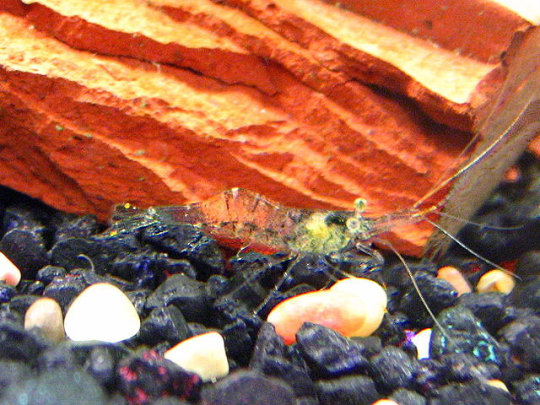
[Image description: Photograph of an glass shrimp in a freshwater aquarium. The shrimp is mostly transparent with its viscera visible, which is different tones of greenish-yellow, as it swims through black and white decorative rocks. End ID]
#glass shrimp#palaemonetes paludosus#they’re also called ghost shrimps >:3c#bottle breaking (inbox emptying)#moth9198
2 notes
·
View notes
Photo


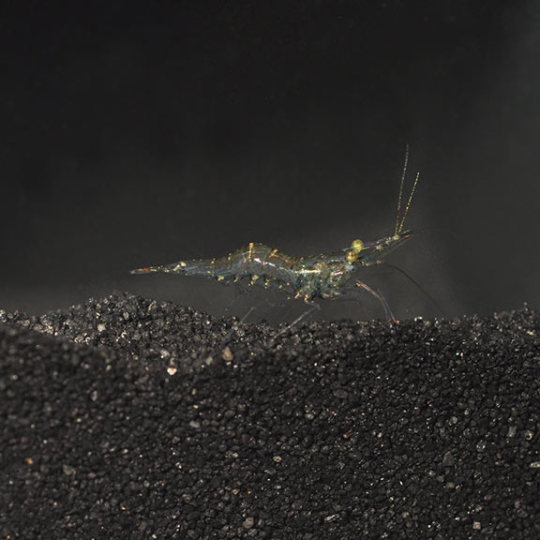


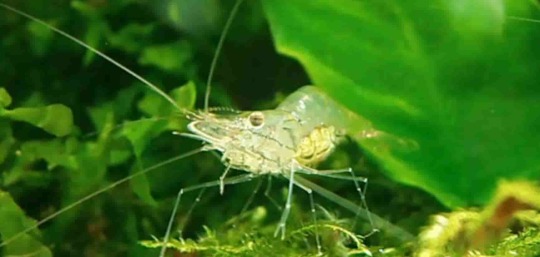
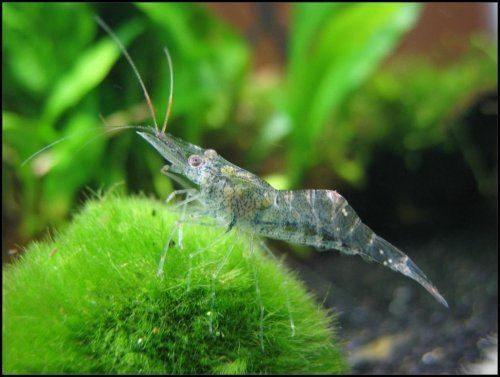
Palaemonetes paludosus better known as ghost shrimp, glass shrimp, and eastern grass shrimp, is a species of freshwater shrimp native to the southeastern United States. Here they can be found throughout freshwater ponds, lakes, and streams east of the Appalachian Mountains from Florida all the way up into New Jersey. They have also been introduced throughout California, Mexico, Louisiana, Texas, and Oklahoma. They are a primarily nocturnal and some what social species which lives in large groups spending there time amongst beds of various aquatic vegetation where they feed upon algae, plankton, the aquatic plants themselves, detritus, and smaller invertebrates chiefly aquatic insects and there larvae. Ghost shrimp are themselves preyed upon by various fish, crayfish, water birds, turtles, and amphibians. Reaching around 1-2 inches (25 – 50mm) in length, ghost shrimp sport a notably transparent carapace and internal tissues allowing one to see its internal organs through its integument. This clearness provides a high degree of camouflage especially in cloudy or muddy water, and is the reason for there common names. The breeding season of these shrimp varies by location and water temperature, during said time the females ovaries take on a greenish color. After mating the female will lay 8 to 35 eggs, and like many crustaceans the mother will carry her developing eggs on their abdomen until they hatch some 2 months later. Ghost shrimp larval development is short, consisting of three stages, and under ideal conditions a ghost shrimp may live upwards of a year.
#ghost#shrimp#glass#eastern#eastern glass shrimp#ghost shrimp#glass shrimp#crustacean#North America#appaliachia#freshwater#pleistocene#pleistocene pride#palaemonetes paludosus
1 note
·
View note
Note
Trick or treat! <3
(I know its not Halloween anymore, but I saw your post about how you wish you couldve done the inbox trick or treating. So, here I am! If you'll have me :3)

What a wonderful worm costume! Your treat is: the daggerblade grass shrimp (Palaemonetes pugio)
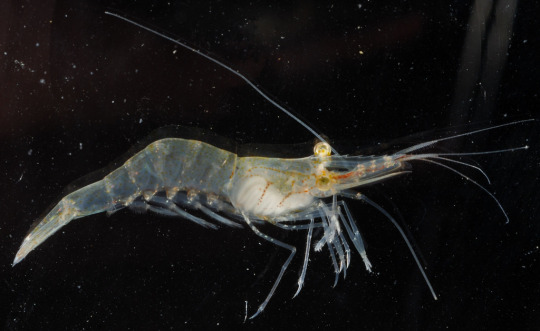
48 notes
·
View notes
Text
VA Native Fish Hunting - 22

Today was a good lesson in things not needing to be exciting to be pleasant. I drove down a back road where I remembered hearing about water access - only to find the access was about 20 feet of mud and rocks. There wasn't even a good place to launch a kayak without getting scraped up. But I still spent a half hour plus there dipping around. My minnow traps came up empty but I managed to get a few neat finds.

In my very first dip I went a little too low and ended up unearthing some rocks - stuck to it was this fella. I wasn't sure what he was at first, but looking through the pictures later it was pretty clear this was a Skilletfish (Gobiesox strumosus), who despite the scientific name aren't related closely at all to true Gobies. Little 2-3 inch long fish, these inoffensive guys are hard to spot even when you are looking for them. But still - a cool fish and a first for me.
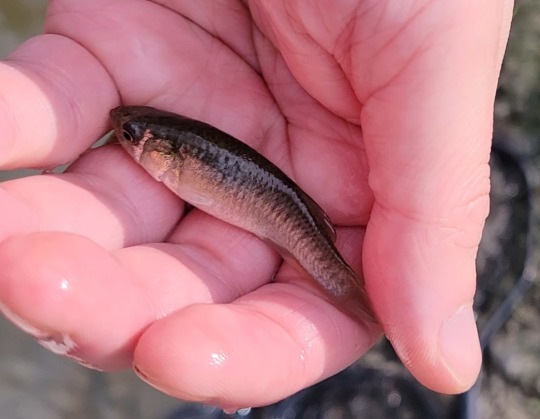
The most common fish here were Mummichogs (Fundulus heteroclitus), which is unsurprising given how populous they are in this river. Even then I only caught maybe 4 or 5 of them. The lack of plant life here to use as shelter really makes it hard for them to avoid the bigger predators we have the in the area, such as White Perches.
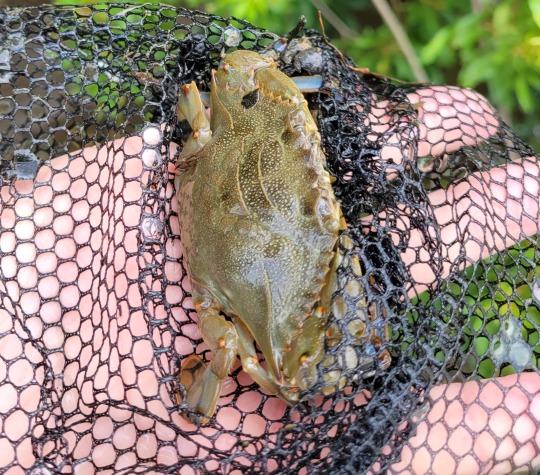
Blue Crabs (Callinectes sapidus) are definitely an iconic species in this area, but sadly they are getting harder to find. Even in the years where they are sparse, there's no shortage of crab traps in the area for people looking to make a buck. I really wish we'd put a moratorium on them for a year or two, I think it would help. Regardless. This little dude was maybe 3.5 inches across the carapace and was a good find.

The most populous invertebrate I caught, by FAR, were these Glass Shrimps (Palaemonetes spp. - probably P. pugio, maybe P. varians). It would be conservative to say I caught over 1 or 2 hundred while I was there with my dumpy little fishing nets. At close to 2 inches long, these guys were chunky little dudes too! I chose this picture to upload because you could cleary see the difference between the berried (right, female) and non-berried (left, presuming male) shrimps. Look at those long whiskers!

Also part of why I left early were the jellyfish, which have been bad this year around here. I avoided the ones near the surface easily enough, but the water was murky and I caught a handful of them near the bottom of the riverbed. Thankfully I was wearing boots, but even then I wasn't interested in potentially harming these guys, so I made like a tree and got out of there.
8 notes
·
View notes
Text
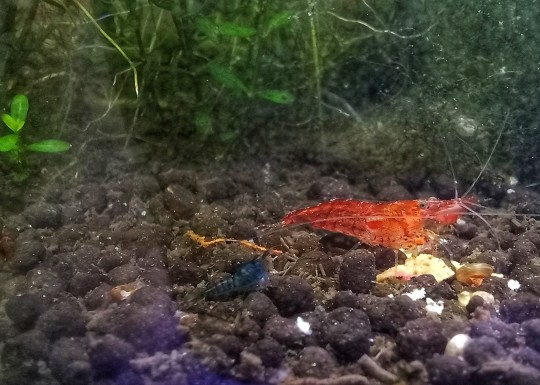
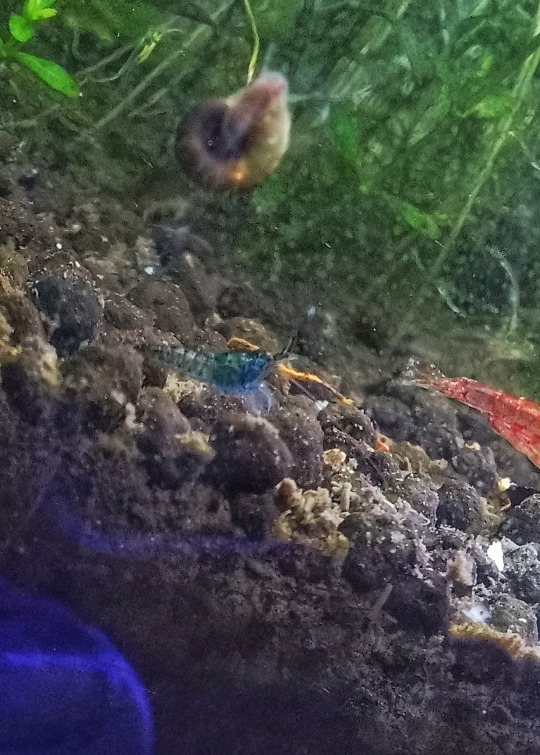
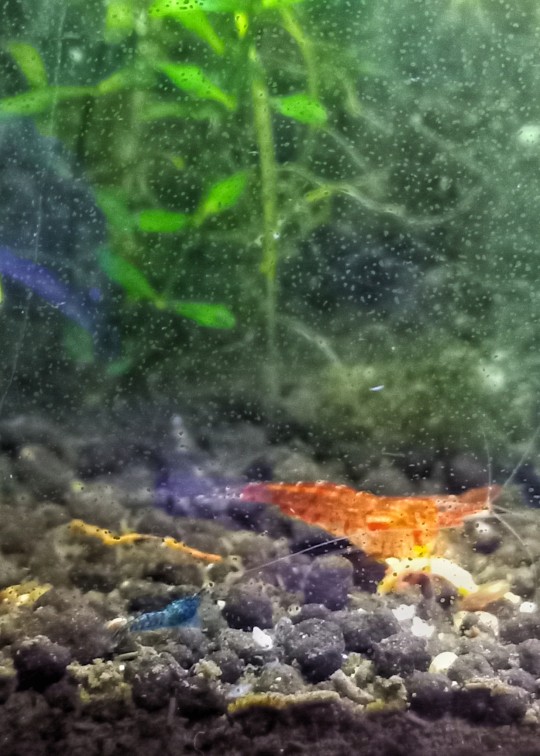
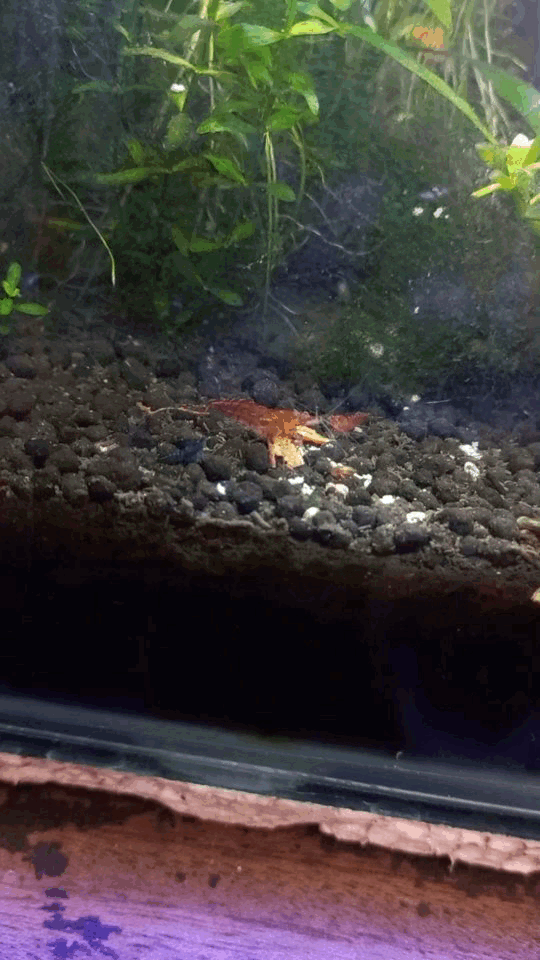
One of the shrimplets is blue 💙
I tried using my macro lens on my phone, but it kept focusing on the algae on the glass instead. The shrimplets are smaller than the grains of substrate, so they're tough to capture and to see. I didn't know where this blue guy came from as I've only bought ghost shrimp and red cherries. I think what must have happened is my aquarium stockists classify neocaridina davidi shrimp that are more translucent as "ghost shrimp" instead of palaemonetes because they are breeders and need to move the stock. Ghost shrimp are less expensive and are sometimes bought for feeder shrimp. I got a few to add to my cleanup crew, and they must have spawned, and one is showing more solid colouration. This may be an encouraging sign of the new feeding combinations I've tried: freeze-dried blood worms and tetra flakes. The tetras love blood worms and extra protein is good for all the tank occupants.
#red cherry shrimp#fish tank#fishkeeping#planted aquarium#aquaposting#shrimpblr#blue shrimp#shrimplet
3 notes
·
View notes
Text
Shrimp of the Day #2
Palaemonetes paludosus
also known as the ghost shrimp, glass shrimp, and eastern grass shrimp


5 notes
·
View notes
Text
Time for POND TALK
So last year I had the idea to keep neocaridina shrimp in my pond. I live in USDA zone 7b, which is pretty warm and I figured a heater would be sufficient for our mild winters. If you follow me on TikTok you'll know this went well at first, but later a sudden unexpected cold snap before I had the heater put an end to this experiment. But this wouldn't have worked anyway: I was very rudely informed of my folly by a severe ice storm that knocked out our power for a week and iced over the pond. Such power outages aren't unusual, especially in the winter, so even a high powered heater can't be counted on. The fish are native fathead minnows and don't even go torpid when their water freezes over, but the shrimp would not have survived. So this past spring I didn't restock.
There is however, a species of tiny shrimp native to this area! I knew this to begin with, but the problem is they're extremely difficult to obtain in hobbyist numbers. They're a type of grass/glass/ghost shrimp, and there are two such species in the US: Palaemonetes paludosus, and Palaemonetes kadiakensis. P. paludosus are found far to the south, preferring warm temperatures and having no real cold hardiness. P. kadiakensis on the other hand ranges as far north as the great lakes. You can buy "ghost shrimp" at pet stores, but they're usually P. paludosus, the Florida grass shrimp. It's very rare for any seller to state what specific species they have though, and in my research I've read of people buying what they thought were P. kadiakensis (aka PK shrimp) but they turned out to be Florida grass shrimp, or even some other variety of prawn entirely. For my situation, there can't be any substitutions, so I had given up on it. Grass shrimp are usually only bought to be used as food for bigger animals, or fishing bait, and people buying them for that don't usually care what specific species they get, so there's little incentive for proper labeling.
More recently though I found one lone eBay seller with labeled PK shrimp, who raises them in an outdoor pond not far from me. They state that their pond freezes over in winter, which implies they do in fact have PKs. There is still some question of whether this is a good idea or not - their pond is no doubt much larger than mine, and even though the bottom of the Big Puddle is below the frost line and has a heater down there, it isn't as warm as a big pond. But try as I might I can't find much useful information. This is one of those things that you have to experiment with on your own. The reason I tried the neocaridina was because I read of people keeping them outdoors further north of me!
Another thing I'm looking into is daphnia, daphnia magna specifically. They're good at eating the algae that cause green water, and they'd make good food for all the dragonflies and tadpoles I get in the summer. Maybe my fish fry would get a chance to survive if they weren't a primary food source for said predators. Seriously, I did have a bunch of fry this year, but only two survived because there are so dang many dragonfly nymphs! The dragonflies kept the American toads from creating a Biblical plague on my backyard though and I appreciate that. I had three toad spawns, one failed for some reason but the other two hatched thousands of tadpoles. I really enjoyed watching them grow, but it wouldn't have been much fun if they'd all survived to adulthood. I don't think a suburb can support 4,000 adult American toads.
Before I can do anything with crustaceans though, I have to wait for my copper test to get here. Crustaceans are very sensitive to copper, which is in algaecide, which I had to use a lot of this summer when the tadpoles' addition of organic matter and hot temperatures caused an explosive algal bloom. Changing out the water isn't a big deal and I'll have to partially drain the pond in the spring anyway, but I want to know exactly what the levels are. I'll have to drain the pond to divide the water lilies, btw: I started with three and this year each of them made at least two babies!
2 notes
·
View notes
Text
Les ruses de l’anémone de mer pour échapper aux prédateurs
See on Scoop.it - EntomoNews
L’anémone étoilée peut produire une toxine qui a le double intérêt de repousser une crevette carnivore et d’attirer un poisson qui s’en nourrit. Mais cette défense se fait au détriment de sa capacité de reproduction.
Par Hervé Morin
Publié le 22 mars 2024 à 06h00
------
NDÉ
L'étude
Venom trade-off shapes interspecific interactions, physiology, and reproduction | Science Advances, 13.03.2024 https://www.science.org/doi/10.1126/sciadv.adk3870
[Image] Population variation of Nv1 and its impact on defense against predators.
(A) Nematostella vectensis. (B) Map showing the location of the different populations of Nematostella across North America. Inset, maximum haploid copy number of Nv1 reported in different Nematostella populations. (C) nCounter relative RNA expression levels of Nv1 from different populations. (D) Grass shrimp (Palaemonetes pugio). Picture taken from Wikimedia by Brian Gratwicke (2006). (E) Mummichog (Fundulus heteroclitus). Picture taken from Wikimedia from the Smithsonian Environmental Research Center. (F) Average weighted score of grass shrimp proximity to Nematostella from NC and FL. (G) Average weighted score of mummichog proximity to Nematostella from NC and FL. Confidence intervals (95%) are indicated by the ends of the vertical error bars. *P < 0.05, **P < 0.01, ***P < 0.001; NS, not significant. Species silhouettes were sourced from PhyloPic. Grass shrimp (P. pugio) and Mummichog (F. heteroclitus) picture taken from Wikimedia. Nematostella photo credit: Yael Admoni.
0 notes
Text
Freshwater Shrimp Tank Guide (The Top Beginner Aquarium Shrimp)
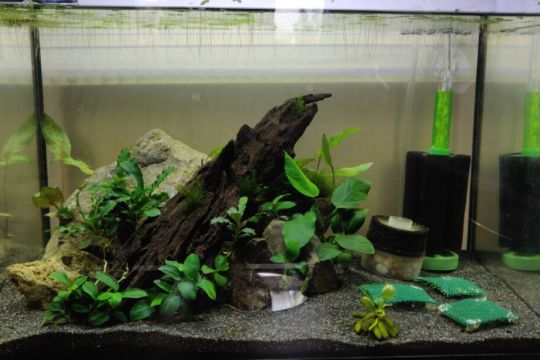
Everyone who keeps fish should have a shrimp tank.
These small creatures are really cool.
Not only are they entertaining to watch as they move around in the dirt, but they also keep algae from growing.
Freshwater shrimp love to graze on algae, but they should also be fed a high-quality tank shrimp food because they eat all the time.
You might not think it's easy to keep freshwater shrimp, but it is.
They can live in tanks as small as 2 gallons and do well in low-tech ponds with plants.
This makes freshwater shrimp great friends for betta fish, especially in planted tanks of 5–10 gallons where the shrimp can hide in Java Moss or other low-light plants.
An Overview of 4 Popular Freshwater Shrimp Species
Sure! Freshwater shrimp are fascinating and popular aquarium inhabitants known for their interesting behaviors and colorful appearances. Here's an overview of four popular freshwater shrimp species:
- Cherry Shrimp (Neocaridina davidi): Cherry shrimp are one of the most popular and commonly kept freshwater shrimp in the aquarium hobby. They are originally from Taiwan and come in various colors, including red, blue, yellow, green, and more. However, the red color variant (Neocaridina davidi var. red) is the most widespread and sought after. Cherry shrimp are relatively easy to care for and breed, making them suitable for beginners. They prefer well-planted aquariums with hiding spots and can coexist with peaceful fish species that won't prey on them.
- Amano Shrimp (Caridina multidentata): Amano shrimp, also known as Yamato shrimp, originate from Japan and have become popular due to their exceptional algae-eating abilities. These shrimp are larger than cherry shrimp and have a transparent body with brown or green markings. They are highly effective at keeping algae growth in check, making them valuable additions to planted aquariums. Amano shrimp are generally peaceful and can coexist with most fish, but they may occasionally become snacks for larger, more aggressive fish.
- Ghost Shrimp (Palaemonetes spp.): Ghost shrimp are commonly available and often used as feeder shrimp for fish, but they can also be kept as aquarium pets. They have a mostly transparent body with some faint markings, hence their name "ghost" shrimp. These shrimp are usually more affordable than some other species. However, they can be sensitive to water quality, so maintaining good water conditions is crucial for their well-being. They are generally peaceful but may be consumed by larger or aggressive tankmates.
- Bamboo Shrimp (Atyopsis spp.): Bamboo shrimp, also known as wood shrimp, are fascinating filter-feeding shrimp that hail from Southeast Asia. They have distinct fan-like appendages that they use to collect food particles from the water column. These shrimp are generally larger than the previously mentioned species, and their coloration can range from brown to green. Bamboo shrimp are a bit more challenging to care for compared to other species, as they require good water flow and a well-established aquarium with plenty of food particles in the water for them to filter-feed on. They are peaceful and should not be kept with aggressive tankmates.
Properly Cycling an Aquarium Shrimp Tank
Properly cycling an aquarium is crucial for establishing a stable and healthy environment for the shrimp to thrive. The cycling process establishes beneficial bacteria in the tank that help convert harmful ammonia into nitrites and then into nitrates, which are less toxic to aquatic life. Here's a step-by-step guide on how to cycle an aquarium shrimp tank:
- Set up the Tank: Place the aquarium in a suitable location, away from direct sunlight and extreme temperature fluctuations. Rinse the tank and any decorations or substrate thoroughly to remove any dust or debris.
- Add Substrate and Decorations: Use an appropriate substrate for your shrimp tank, such as fine-grain sand or aquarium soil, as it provides a natural environment and aids in the growth of beneficial bacteria. Add any decorations or plants, ensuring they are shrimp-safe and won't leach harmful chemicals into the water.
- Fill the Tank with Water: Use dechlorinated water to fill the tank. Chlorine and chloramine in tap water can be harmful to shrimp and can kill the beneficial bacteria needed for cycling. You can use a dechlorinator to neutralize these chemicals.
- Introduce Ammonia Source: To kickstart the cycling process, introduce an ammonia source into the tank. This can be done using fish food, pure ammonia (without additives), or established filter media from a cycled aquarium. For fish food, add a small amount to the tank to rot and produce ammonia over time.
- Test Water Parameters: Regularly test the water parameters throughout the cycling process. Important parameters to monitor include ammonia, nitrites, nitrates, pH, and temperature. The goal is to see a rise in ammonia levels, followed by a peak in nitrite levels, and finally, a decrease in both as nitrates increase.
- Be Patient: The cycling process typically takes several weeks to complete, depending on factors like tank size, the amount of ammonia introduced, and water temperature. Patience is key during this time, as rushing the process can be harmful to the shrimp.
- Water Changes: During the cycling process, you may need to perform partial water changes to keep ammonia and nitrite levels in check. Aim to keep ammonia levels below 1 ppm and nitrite levels as close to 0 ppm as possible.
- Test for Nitrates: Once the cycling process is complete, nitrates should be present in the tank. Nitrates are less harmful than ammonia and nitrites, but high levels can still be detrimental to shrimp. Perform regular water changes to keep nitrates at safe levels, ideally below 20 ppm.
- Introduce Shrimp: After confirming that ammonia and nitrite levels are at safe levels, and nitrates are present, the tank is ready for shrimp. Start with a small group of shrimp to minimize the impact on the water parameters. Acclimate the shrimp slowly to prevent stress.
- Monitor and Maintain: Once the shrimp are in the tank, continue to monitor water parameters regularly and perform routine maintenance, such as water changes and cleaning the filter, to ensure a healthy and stable environment for the shrimp.
Cherry Shrimp Facts:
• Lifespan: 1-2 years
• Size: about 1.5 inches
• Personality: peaceful and active
• Care level: easy
• Tank size: 2+ gallons
Cherry Shrimp Grades
Cherry shrimp (Neocaridina davidi) are popular in the aquarium hobby not only for their ease of care but also for their vibrant and diverse colors. These colors are graded based on their intensity, coverage, and overall appearance. The grading system for cherry shrimp is not standardized across the entire hobby, and different regions or breeders might have their grading scales. However, a common grading system for cherry shrimp includes the following grades:
- Cherry Shrimp (low-grade): The low-grade cherry shrimp are usually the most basic and least intense in coloration. They may have pale or faded colors and often show less coverage of the desired color. In this grade, you might find some clear or wild-type shrimp mixed with those displaying a bit of red or other colors.
- Sakura Shrimp (mid-grade): Sakura shrimp are an intermediate grade, showing more color intensity and coverage than low-grade shrimp. The red coloration starts to become more noticeable and consistent, but it may not be as deep or solid as the higher-grade variants. Sakura shrimp generally have a more solid red coloration on their body and carapace.
- Fire Red Shrimp (high-grade): Fire red shrimp are the higher-quality and more sought-after cherry shrimp. They exhibit a vibrant and solid red coloration, covering most of their body and carapace. The intensity and brightness of red are more pronounced in these shrimp compared to the lower grades. They are often bred selectively to maintain their intense red coloration.
- Painted Fire Red Shrimp (high-grade): The painted fire red shrimp are the highest grade in the cherry shrimp color spectrum. They display an exceptional, vivid, and solid red coloration, with virtually no clear or off-color areas. These shrimp have been selectively bred for generations to maintain their intense coloration and are typically more expensive and rare compared to lower grades.
Feeding Cherry Shrimp
Feeding cherry shrimp is relatively easy, as they are omnivorous scavengers and will consume a variety of foods. Providing a balanced diet is essential for their health, growth, and vibrant coloration. Here are some tips for feeding cherry shrimp:
- High-Quality Shrimp Food: Use high-quality shrimp-specific food as the primary diet for your cherry shrimp. Look for specialized shrimp pellets or granules that contain essential nutrients for their well-being. These foods are formulated to meet the specific dietary needs of shrimp and will help enhance their coloration and overall health.
- Vegetable-Based Foods: Cherry shrimp also enjoy vegetable-based foods. You can offer them blanched vegetables such as spinach, zucchini, cucumber, or lettuce. Simply boil or steam the vegetables until soft, and then place them in the tank for the shrimp to nibble on. Remove any uneaten vegetables after a few hours to prevent water quality issues.
- Protein-Rich Foods: In addition to their plant-based diet, cherry shrimp need protein-rich foods to support their growth and molting. You can feed them small amounts of high-quality fish food, brine shrimp, or other protein-rich treats occasionally.
- Algae and Biofilm: Cherry shrimp are excellent algae eaters, and they will graze on algae and biofilm that naturally grow in the aquarium. A well-maintained planted tank with some algae growth will provide a natural food source for the shrimp. However, if algae are insufficient, supplement their diet with the foods mentioned above.
- Feed in Moderation: Shrimp have small digestive systems, and overfeeding can lead to water quality issues. Offer small amounts of food that the shrimp can consume within a few hours. Remove any uneaten food to avoid polluting the water.
- Frequency of Feeding: Feeding once a day is generally sufficient for cherry shrimp. However, you can adjust the feeding frequency based on the amount of food consumed and the overall health of the shrimp. Some shrimp keepers choose to feed every other day to prevent excessive waste buildup.
- Observe and Adjust: Observe the shrimp's behavior and appearance regularly to ensure they are healthy and thriving. Adjust the feeding regimen as needed based on their activity level and overall well-being.
Breeding Cherry Shrimp
Breeding cherry shrimp (Neocaridina davidi) is a fascinating and rewarding process. These shrimp are prolific breeders, and under the right conditions, they can reproduce rapidly. Here's a step-by-step guide to breeding cherry shrimp:
- Provide Optimal Water Conditions: To encourage successful breeding, maintain stable and optimal water conditions. Cherry shrimp prefer a temperature range of 70°F to 78°F (21°C to 26°C) and a pH level between 6.5 to 7.5. Keep the water clean and free from any harmful substances like ammonia, nitrites, and high nitrates. Stable water parameters are crucial for the well-being of the shrimp and their offspring.
- Create a Suitable Environment: Provide plenty of hiding places and densely planted areas in the tank. Mosses, java ferns, and other fine-leaved plants serve as great hiding spots for shrimp and their baby shrimplets. Having a well-established aquarium with biofilm and algae growth will also help provide natural food sources for the newborn shrimp.
- Introduce Both Male and Female Shrimp: Ensure that you have a good ratio of male and female cherry shrimp in the tank. A balanced population will increase the likelihood of successful mating and breeding.
- Recognize Gravid Females: Gravid females are females carrying eggs beneath their abdomen. As the eggs develop, you will notice a saddle-like structure on their back. When the eggs are ready to hatch, the saddle will turn darker and become more prominent.
- Molting and Reproduction: Before breeding, the female cherry shrimp will molt to shed her exoskeleton. After molting, she releases pheromones to attract males for mating. During mating, the male deposits sperm packets known as spermatophores, which the female picks up and uses to fertilize her eggs.
- Egg Development and Birth: Once fertilized, the female will carry the eggs beneath her abdomen until they hatch. The gestation period is typically around 3 to 4 weeks. When the time comes, the female will release the tiny, fully formed shrimplets into the tank. The newborn shrimp are independent and will immediately start foraging for food.
- Provide Ample Food: To ensure the survival of the shrimplets, make sure there is an abundance of small, nutritious food available in the tank. Crushed fish food, specialized shrimp pellets, and algae growth will serve as excellent food sources for the baby shrimp.
- Separate Predators: If your main aquarium contains fish or other predatory species, consider moving the pregnant female or the newborn shrimp to a separate breeding tank. This will prevent the shrimplets from being predated upon, increasing their chances of survival.
- Monitor and Enjoy: Continue to observe the breeding tank regularly and provide adequate care to maintain water quality. As the cherry shrimp population grows, you can enjoy the vibrant colors and fascinating behaviors of these tiny creatures.
Cherry Shrimp Tank Mates
When selecting tank mates for cherry shrimp (Neocaridina davidi), it's essential to choose peaceful, non-predatory species that won't harm or stress the shrimp. Shrimp can become prey for larger or more aggressive fish, so it's crucial to create a harmonious community that allows the cherry shrimp to thrive. Here are some suitable tank mates for cherry shrimp:
- Small and Peaceful Fish: Some small, non-aggressive fish can coexist with cherry shrimp. Examples include small rasboras (e.g., Chili Rasbora, Microdevario kubotai), small tetras (e.g., Ember Tetra, Neon Tetra), and small gouramis (e.g., Dwarf Gourami). These fish generally won't bother the shrimp and are peaceful enough not to pose a threat to them.
- Corydoras Catfish: Corydoras catfish are bottom-dwelling fish known for their peaceful nature. They are compatible with cherry shrimp and can help clean up leftover food and debris from the tank's substrate.
- Otocinclus Catfish: Otocinclus catfish are small algae eaters that can peacefully coexist with cherry shrimp. They help control algae growth in the tank and usually won't bother the shrimp.
- Snails: Various species of snails, such as Nerite snails and Mystery snails, can make good tank mates for cherry shrimp. They help keep the tank clean by consuming algae and detritus.
- Shrimp-Only Tanks: For a thriving cherry shrimp colony, consider keeping them in a shrimp-only tank. This eliminates any risk of predation or aggression from other fish species. A well-planted tank with lots of hiding spots and natural food sources will provide an ideal environment for the shrimp to thrive.
Crystal Red Shrimp
Crystal Red Shrimp (Caridina cantonensis var. "Crystal Red") are a highly sought-after and fascinating freshwater shrimp species in the aquarium hobby. They belong to the Caridina genus and are known for their striking red and white coloration, which resembles a crystal pattern, giving them their name. Here's some essential information about Crystal Red Shrimp:
Appearance: Crystal Red Shrimp have a distinctive color pattern with varying degrees of white and red. The intensity and quality of their coloration are graded on a scale from C to S, with C being the least intense and S being the most intense and desirable coloration. High-quality Crystal Red Shrimp have prominent white and red bands running parallel along their bodies, creating a beautiful and eye-catching contrast.
Water Parameters: Crystal Red Shrimp require stable and specific water parameters to thrive. They prefer soft, slightly acidic to neutral water conditions. The ideal parameters for these shrimp are a temperature of 68°F to 78°F (20°C to 26°C), pH between 6.0 to 7.5, GH of 4 to 6, and KH of 0 to 4. Maintaining these parameters is crucial for their overall health and coloration.
Feeding: Crystal Red Shrimp are omnivorous and will consume a variety of foods. Provide them with specialized shrimp pellets or granules, algae wafers, and blanched vegetables like spinach, zucchini, or cucumber. Additionally, they will graze on biofilm and algae in the aquarium.
Breeding: Breeding Crystal Red Shrimp can be more challenging compared to other shrimp species, such as Cherry Shrimp. It requires careful attention to water conditions and genetics to produce high-quality offspring. To breed them successfully, maintain stable water parameters and ensure proper nutrition for the shrimp.
Tank Mates: When selecting tank mates for Crystal Red Shrimp, it's essential to choose peaceful and non-predatory species. Small, non-aggressive fish like small rasboras, small tetras, or shrimp-safe snails can make suitable companions. It's best to avoid keeping them with larger or aggressive fish that may pose a threat to the shrimp.
Selective Breeding: Crystal Red Shrimp come in different grades based on their coloration and patterns. Breeders often engage in selective breeding to enhance desirable traits and produce higher-grade shrimp with more intense red and white coloration.
Crystal Shrimp Water Conditions
Maintaining optimal water conditions is crucial for the health and well-being of Crystal Red Shrimp (Caridina cantonensis var. "Crystal Red"). These shrimp have specific requirements to display their vibrant coloration and thrive in the aquarium. Here are the recommended water parameters for Crystal Red Shrimp:
- Temperature: Crystal Red Shrimp prefer a temperature range of 68°F to 78°F (20°C to 26°C). Keeping the water within this range provides a stable environment for the shrimp.
- pH Level: The ideal pH range for Crystal Red Shrimp is slightly acidic to neutral, typically between 6.0 to 7.5. It's essential to maintain a stable pH level, as significant fluctuations can stress the shrimp.
- Water Hardness: Crystal Red Shrimp require soft water with a general hardness (GH) of 4 to 6 degrees. They are sensitive to high levels of minerals in the water, so it's essential to keep the GH within this range.
- Carbonate Hardness: The carbonate hardness (KH) should be low, ideally ranging from 0 to 4 degrees. Low KH helps maintain a stable pH, which is essential for the health of the shrimp.
- Ammonia and Nitrites: Crystal Red Shrimp are sensitive to ammonia and nitrites. It's crucial to keep ammonia and nitrite levels at 0 ppm, as any presence of these harmful compounds can harm or even kill the shrimp.
- Nitrates: While Crystal Red Shrimp are more tolerant of nitrates than ammonia and nitrites, it's still essential to keep nitrate levels as low as possible.
Read the full article
0 notes
Text
Easysps EVO: fitoplancton adatto per essere dosato con pompa dosometrica
Easysps EVO: fitoplancton adatto per essere dosato con pompa dosometrica - Finalmente abbiamo un fitoplancton che può essere dosato tramite pompa dosometrica direttamente in acquario.
Un nuovo articolo su http://www.danireef.com/2021/05/20/easysps-evo-fitoplancton-adatto-per-essere-dosato-con-pompa-dosometrica/
Easysps EVO: fitoplancton adatto per essere dosato con pompa dosometrica
#Agp, #EasyReefs, #Easysps, #Fitoplancton, #Isochrysis, #Palaemonetes, #Phaeodactylum, #Tetraselmis
- by Danilo Ronchi
0 notes
Photo
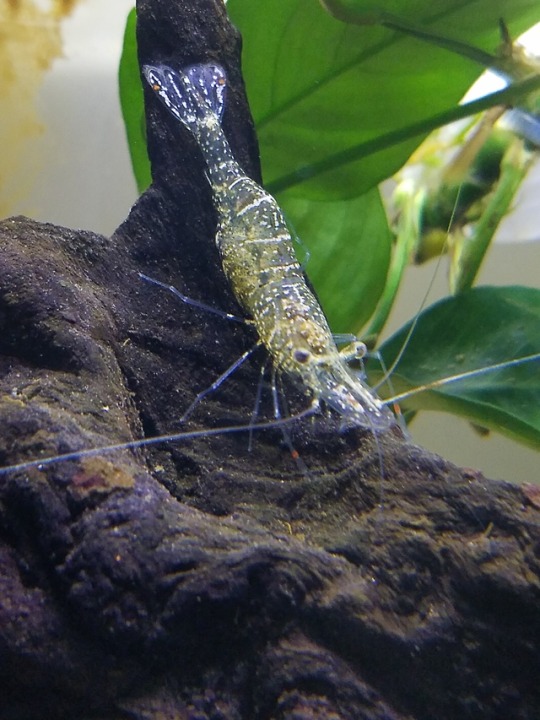
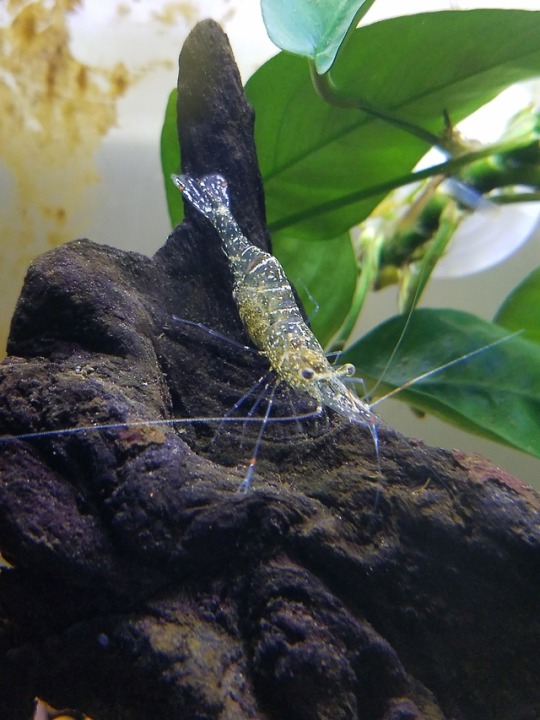
Some awesome pictures of my gravid female ghost shrimp (Palaemonetes sp.).
5 notes
·
View notes
Note
What are some good shrimp to keep for people who’ve never kept them before?
Shrimp in general tend to be not too tricky, though of course as with all animals there's a learning curve and some are more sensitive than others. Ultimately I would recommend looking at your options and deciding which interests you the most and go from there to see if their care is doable for you.
Look at their native habitat, speak to keepers and breeders, join some specialty shrimp groups or forums, etc.
Here's a list of some species to consider:
-Amano shrimp (Caridina multidentata)
-Glass/ghost shrimp (Palaemonetes paludosus)
-Opae ula (Halocaridina rubra)
-Bee shrimp (Caridina cantonensis)
-Cherry shrimp (Neocaridina davidi)
-Bamboo shrimp (Atyopsis moluccensis)
12 notes
·
View notes
Note
Do you think Ditch Shrimp would attack smaller inverts/shrimp, or the larvae of smaller shrimp?
All of the Palaemonetes shrimps I've dealt with have all been opportunistic predators; most are fine with same size or slightly smaller tank mates, but I've seen Ghost Shrimp eat Cherry Shrimp and livebearer fry. So yes, I would say that they are a risk. I wouldn't expect them to attack something like full sized Mosquitofish or similar sized critters.
4 notes
·
View notes
Text
Glass Shrimp tippy taps
Palaemonetes, its common names include glass shrimp, ghost shrimp, feeder shrimp, is a genus of caridean shrimp comprising a geographically diverse group of fresh water, brackish and marine crustaceans

Tiny claws for tiny meals...
7 notes
·
View notes
Text
VA Native Fish Hunting - 14

Today was a fun day down on the Potomac. I went specifically to capture Striped Killifish (no luck) but also found shark teeth and petrified bones. Oh, and found some other aquatic stuff. So, that's always neat.

For the first hour I didn't catch anything. Hard time finding any fish at all, probably because it was high tide. Most of the fish I saw last time were around a sand bar which was no longer present. Once I started netting around some seaweed randomly (looking for Gobies) I started catching Eastern Grass Shrimp (Palaemonetes paludosus). Love these little guys.

A handful of the shrimps I caught were females, berried with lots of eggs. I tried not to pester them too much, but who can resist the opportunity to take a picture? I've heard Palaemonetes needs freshwater and brackish to breed and raise eggs - given where I found the berried females (near the inlet) there might be some truth to that.

Okay, well. They were pretty common in some areas. I was catching 4 or 6 in single swipes at some locations. I am tempted to use them in a biotope tank someday!

I never was able to find any Striped Killifish, but I did eventually catch this Mummichog (Fundulus heteroclitus). These are also brackish to full marine and are very hardy - I have one already in my saltwater tank after all.

I managed to catch 6 of them - 3 of which were suffering from leeches. I transitioned the 'chogs to full saltwater (from 1.006) and hoped it would kill off the leeches but nope - still sticking strong. So I removed them with tweezers. Not a fun way to spend a day but yknow. I think my existing Mummichog will love the company.
6 notes
·
View notes
Text
Sederet Hewan Transparan di Dunia: dari Katak Kaca hingga Udang Hantu
7Meter - Banyak hewan di dunia yang punya karakteristik aneh dan berbeda dari binatang yang lain. Salah satunya adalah keberadaan hewan-hewan yang transparan.

Karena transparan, kita bisa melihat organ dalam dari binatang ini meski bagian dalam tubuh mereka sebenarnya terbungkus oleh kulit. Banyak dari tubuh transparan mereka yang berfungsi untuk mencegah predator, tapi ada juga yang justru berguna agar mereka bisa memangsa dengan lebih baik.
Lantas, hewan-hewan apa saja sih yang punya tubuh transparan? Tanpa panjang lebar lagi, berikut 5 hewan transparan yang ada di dunia.
Katak Kaca
Katak Kaca sebenarnya memiliki kulit berwarna hijau muda di bagian punggung belakang. Namun, katak yang hidup di hutan tropis Amerika Tengah dan Selatan ini punya kulit tembus cahaya di bagian kaki hingga transparan di bagian perut.
Tubuh transparan itu membuat kita bisa melihat isi tubuh Katak Kaca dengan jelas. Kita bahkan bisa melihat keberadaan detak jantung, pembuluh darah, tulang dan saluran pencernaan dari katak tersebut.
Menurut studi yang dipublikasiProceedingsof the National Academy of Sciences pada Maret 2020, para ilmuwan menyebut kalau tubuh transparan mereka berguna untuk kamuflase dari serangan predator. Kaki yang tembus cahaya dan bagian perut transparan membantu katak bisa menyesuaikan warna mereka dengan daun tempat mereka beristirahat.
"Katak selalu (berwarna) hijau untuk mencocokkan daun secara umum, tetapi kecerahan daunnya berbeda,” kata anggota peneliti dari McMaster University, James Barnett, kepada The Guardian.
“Dengan memiliki kaki tembus pandang dan beristirahat dengan kaki mengelilingi tubuh, tepi katak diubah menjadi gradien yang lebih lembut, kurang kontras dari daun ke kaki, dan lagi dari kaki ke tubuh."
Kenari Laut
Mnemiopsis leidyi atau biasa dikenal sebagai Sea Walnut (Kenari Laut) adalah salah satu spesies dalam kategori ubur-ubur sisir (comb jellies).
Nama 'Kenari Laut' merujuk kepada bentuk tubuhnya yang mirip seperti biji kenari. Ia memiliki tubuh melengkung berbentuk oval dan transparan, dengan empat baris sisir bersilia yang membentang di sepanjang tubuh secara vertikal
Tubuh Kenari Laut sendiri terdiri dari 97% air. Ia tidak menyengat, namun akan bersinar biru kehijauan jika diganggu.
Barreleye Fish
Barreleye fish boleh jadi merupakan ikan unik dengan bentuk teraneh di dunia. Ia memiliki kepala yang transparan, membuat dirinya tampak seperti pesawat dengan kokpit yang dapat dilihat dari luar.
Penemuan kepala transparan Barreleye fish sendiri bermula pada tahun 2004 lalu. Kala itu, para peneliti dari Monterey Bay Aquarium Research Institute (MBARI) sedang menjelajahi lepas pantai California, AS, dengan kendaraan yang dioperasikan dari jarak jauh (remotely operated vehicle/ROV).
Saat menjelajah di kedalaman 600 meter, mereka merekam cuplikan pertama Bareleye Pasifik (Macropinnamicrostoma) yang hidup. Video itu menunjukkan kalau Barreleye fish punya mata berbentuk seperti tong (barrel) yang dapat berputar di bawah pelindungnya, sehingga memungkinkan ikan untuk mengintip ke atas, ke depan, atau ke bawah.
Sebelumnya, ikan ini hanya pernah ditemukan dalam keadaan mati. Semua spesimen yang pernah ditemukan juga kehilangan 'tudung' transparan yang oleh ahli biologi kelautan Helen Scales, disebut sebagai "gelembung bening seperti helm astronaut".
“Lautan adalah lingkungan 3D yang hampir tak terbatas,” kata Scales kepada BBC. “Jadi ada tekanan selektif untuk kemampuan memindai di atas dan di bawah. Lebih banyak ikan seperti ini mungkin menunggu untuk ditemukan. "
Para peneliti sendiri menyebut kalau mata berbentuk tong dari Barreleye fish berguna untuk mendeteksi calon mangsa yang berenang di atasnya.
Kupu-kupu Sayap Kaca
Kupu-kupu sayap kaca (Greta oto) memiliki sayap yang sangat transparan. Saking beningnya sayap mereka, kita bahkan bisa membaca tulisan yang dihalangi oleh sayap Greta oto, seperti yang ditunjukkan sekelompok peneliti Jerman di jurnal Nature Communications berikut ini.
Di Amerika Tengah, tempat kupu-kupu ini berasal, ia umumnya dikenal sebagai 'espejitos', yang berarti 'cermin kecil'. Meski demikian, sayap mereka sebenarnya sangat berbeda dengan cermin dan hampir tidak memantulkan cahaya sama sekali.
Menurut laporan Science Focus, penyebutan itu merujuk kepada bagian bening sayap mereka yang tidak bersisik dan memiliki struktur lilin sangat kecil yang disebut nanopilar. Bagian ini tersusun secara acak di seluruh permukaan sayap untuk berfungsi sebagai lapisan anti-reflektif. Meski belum terbukti secara ilmiah, karakteristik ini diduga dimanfaatkan oleh Greta oto untuk mempersulit predator melihat mereka.
Udang Hantu
Di dunia ini, sebenarnya banyak jenis udang yang memiliki kulit tembus pandang dengan tingkat berbeda-beda. Melalui kulit yang transparan itu, kita bisa melihat bagian dalam tubuh udang, mulai dari santapan yang terakhir mereka makan hingga kumpulan telur berkembang.
Menurut laporan Science Focus, tubuh yang transparan berguna bagi udang untuk berkamuflase dengan latar belakangnya, baik di perairan terbuka, dasar laut, atau terumbu karang.
Udang transparan sendiri umumnya dikenal dengan berbagai nama, mulai dari udang hantu hingga udang kaca. Namun, umumnya penyebutan itu merujuk kepada genus udang bernama Palaemonetes yang terkenal karena memiliki turunan spesies dengan tubuh transparan.
0 notes